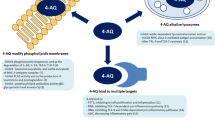Summary
The main types of adverse effects associated with quinolones are uncommon and reversible and vary in frequency among different agents. Phototoxicity appears more frequent with lomefloxacin than with some other quinolones. Three mechanisms have been proposed to explain the neurotoxic effects, including rare proconvulsant activity, associated with quinolone therapy. Arthropathy remains a dilemma for paediatricians deciding whether to use quinolones in growing children. Importantly, the experience with temafloxacin, which has now been withdrawn from the market, emphasises the need for thorough postmarketing surveillance. Nonetheless, it should be remembered that the fluoroquinolones as a group are effective and very well tolerated antimicrobial drugs.
Similar content being viewed by others
References
Blum MD, Graham DJ, McClosley CA. Temafloxacin syndrome: review of 95 cases. Clin Infect Dis 1994; 18: 946–50
Norrby SR, Lietman PL. Safety and tolerability of fluoroquinolones. Drugs 1993; 45 Suppl. 3: 59–64
Deamer RL, Prichard JG, Koenker N, et al. Temafloxacin-induced hemolytic anemia and renal failure. Clin Pharm 1993; 12: 380–2
Ray WA, Griffin MR, Avorn J. Evaluating drugs after their approval for clinical use. New Engl J Med 1993; 329 (27): 2029–32
Neringer R, Forsgren A, Hansson C. Lomefloxacin versus norfloxacin in the treatment of uncomplicated urinary tract infections: three-day versus seven-day treatment. Scand J Infect Dis 1992; 24: 773–80
Iravani A. Efficacy of lomefloxacin as compared to norfloxacin in the treatment of uncomplicated urinary tract infections in adults. Am J Med 1992; 92 Suppl. 4A: 75–81S
Marutani K, Matsumoto M, Otabe Y, et al. Reduced phototoxicity of a fluoroquinolone antibacterial agent with a methoxy group at the 8 position in mice irradiated with long-wavelength UV light. Antimicrob Agents Chemother 1993; 37 (10): 2217–23
Matsumoto M, Kojima K, Nagano N, et al. Photostability and biological activity of fluoroquinolones substituted at the 8 position after UV irradiation. Antimicrob Agents Chemother 1992; 36 (8): 1715–9
Hagen SE, Domagala JM, Gracheck J, et al. Synthesis and antibacterial activity of new quinolones containing a 7-[3-(1-amino-1-methylethyl)-1-pyrrolidinyl] moeity. Gram-positive agents with excellent oral activity and low side-effect potential. J Med Chem 1994; 37: 733–8
Domagala JM, Hagen SE, Joannides T, et al. Quinolone anti-bacterials containing the new 7-[3-(1-aminoethyl)-1-pyrrolidinyl] side chain: the effects of the 1-aminoethyl moeity and its stereochemical configurations on potency and in vivo efficacy. J Med Chem 1993; 36: 8711–82
Halliwell RF, Davey PG, Lambert JJ. Antagonism of GABAA receptors by 4-quinolones. J Antimicrobial Chemother 1993; 31: 457–62
Halliwell RP, Davey PG, Lambert JJ. The effects of quinolones and NSAIDs upon GABA-evoked currents recorded from rat dorsal root ganglion neurones. J Antimicrob Chemother 1991; 27: 209–18
Davey PG, Charter M, Kelly S, et al. Ciprofloxacin and sparfloxacin penetration into human brain tissue and their activity as antagonists of GABAA receptor of rat vagus nerve. Antimicrob Agents Chemother 1994; 38: (6) 1356–62
DeSarro A, Zappala M, Chimirri A, et al. Quinolones potentiate cefazolin-induced seizures in DBA/2 mice. Antimicrob Agents Chemother 1993; 37 (7): 1497–503
Dani>sovicová A, Krcméryová T, Belan S, et al. Magnetic resonance imaging in diagnosis of potential arthropathogenicity in children receiving quinolones: no evidence of quinolone-induced arthropathy. Drugs 1995; 49 Suppl. 2: 492–4
Kubin R. Safety and efficacy of ciprofloxacin in paediatric parents [review]. Infection 1993; 21 (6): 413–21
Schroeder DJ, Hart LL, Lynch SS. Potential quinolone-induced cartilage toxicity in children. Ann Pharmacother 1994; 28: 336–8
Hildebrand H, Kemplca G, Schluter G, et al. Chondrotoxicity of quinolones in vivo and in vitro. Arch Toxicol 1993; 67: 411–5
Takada S, Kato M, Takayama S. Comparison of lesions induced by intra-articular injections of quinolones and compounds damaging cartilage components in rat femoral condyles. J Toxicol Environ Health 1994; 42: 73–88
Hayem G, Pettit PX, Levacher M, et al. Cytofluorometric analysis of chondrotoxicity of fluoroquinolone antimicrobial agents. Antimicrob Agents Chemother 1994; 38 (2): 243–7
Author information
Authors and Affiliations
Rights and permissions
About this article
Cite this article
Lietman, P.S. Fluoroquinolone Toxicities. Drugs 49 (Suppl 2), 159–163 (1995). https://doi.org/10.2165/00003495-199500492-00026
Published:
Issue Date:
DOI: https://doi.org/10.2165/00003495-199500492-00026




